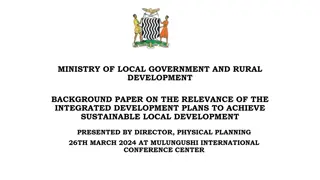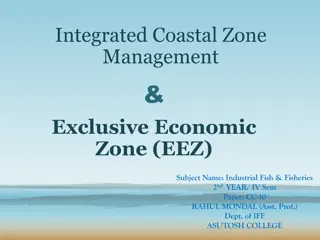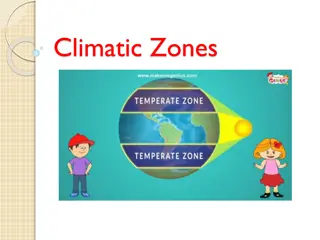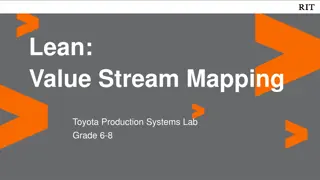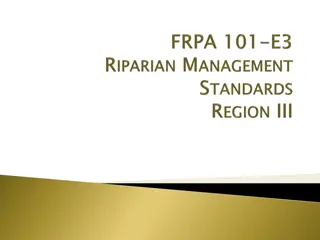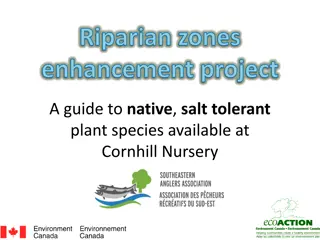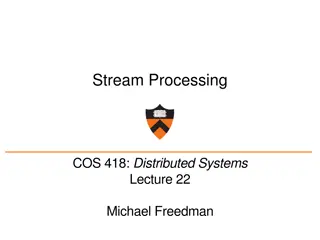Integrated Approach for Stream Network Development and Riparian Zone Analysis
This project aims to build a seamless stream network, apply riparian zone delineation tools, and assess various environmental factors affecting stream ecosystems. The integration of data and analysis tools provides a comprehensive understanding of stream dynamics and habitat potential.
Download Presentation

Please find below an Image/Link to download the presentation.
The content on the website is provided AS IS for your information and personal use only. It may not be sold, licensed, or shared on other websites without obtaining consent from the author.If you encounter any issues during the download, it is possible that the publisher has removed the file from their server.
You are allowed to download the files provided on this website for personal or commercial use, subject to the condition that they are used lawfully. All files are the property of their respective owners.
The content on the website is provided AS IS for your information and personal use only. It may not be sold, licensed, or shared on other websites without obtaining consent from the author.
E N D
Presentation Transcript
To main objectives: Build a seamless, routed stream network across WAM tiles Apply a process based, riparian zone delineation tool Riparian Processes Depth to water (WAM) Floodplains In-stream wood recruitment Current vegetation shade effects on thermal energy to streams Add Environmental Settings (not included) Channel types Habitat (fish) potential Hillslope erosion potential Channel migration Thermal refugia Tributary confluence zones Wildfire risk Climate change
Figure 12. The Integrated WAM-NetMap node based synthetic stream layer with drainage wings.
Figure 15. Sinuosity of the stream lines in the Integrated WAM-NetMap is significantly greater than natural river channels in the study area.
Table 1. List of attributes contained within the Integrated WAM-NetMap to support spatially explicit riparian zone delineation and environmental settings. Riparian Process/Delineation Parameters (units) Environmental Settings Parameters (units) Synthetic Stream Layer (Integrated WAM-NetMap) Channel Classification (types)* Depth to Water (WAM, in meters) Stream order (Strahler 1952) Drainage area (km2) Channel confinement (LL-1) Entrenchment ratio (LL-1)* Elevation (m) Gradient (LL-1) Hillslope erosion potential (GEP) Azimuth (0 360o) Sinuosity (LL-1) Bankfull width (m) Tributary confluence effects (P) Thermal refugia (watt-hours/m2 or indexed by contributing area) Bankfull depth (m) Valley Elevations/Floodplain width (n=5, m) Channel Migration Zone (m)* Maximum downstream gradient (LL-1) Topography (slope, curvature, distance to stream) Mean annual flow (m3s-1) Aquatic (Fish) Habitats* Mean annual flow (m3s-1) Mean annual precipitation (m) Thermal Energy to Channels (Bare Earth, watt-hours /m2) Summer habitat volume (m3)* Current Shade (tree height and basal area) Wildfire risk** In-stream wood recruitment (tree height, stand density, diameter classes) Climate change forecasts** Riparian vegetation (basal area, average tree height, average stand density, quadratic mean diameter)
Figure 13. An illustration of valley floor mapping in the Integrated WAM-NetMap.
Figure 17. An example of two different types of valley floor and floodplain mapping in the Simonette River basin.
Figure 16. The WAM depth to water in the Simonette River pilot project area compared to floodplain mapping.
Figure 19. Bare earth radiation loading to streams in the Simonette River -latitude -solar angle -topographic shading -stream width -stream azimuth -vegetation height -vegetation width -vegetation density
Shade model (Groom et al. 2011) uses basal area and tree height
Figure 20. Current streamside shade influenced thermal energy to streams using basal area and tree height.
Spatially explicit, variable width riparian zone delineation model
Predicted Spatial Variability in Delineated Riparian Zone in the Simonette basin





